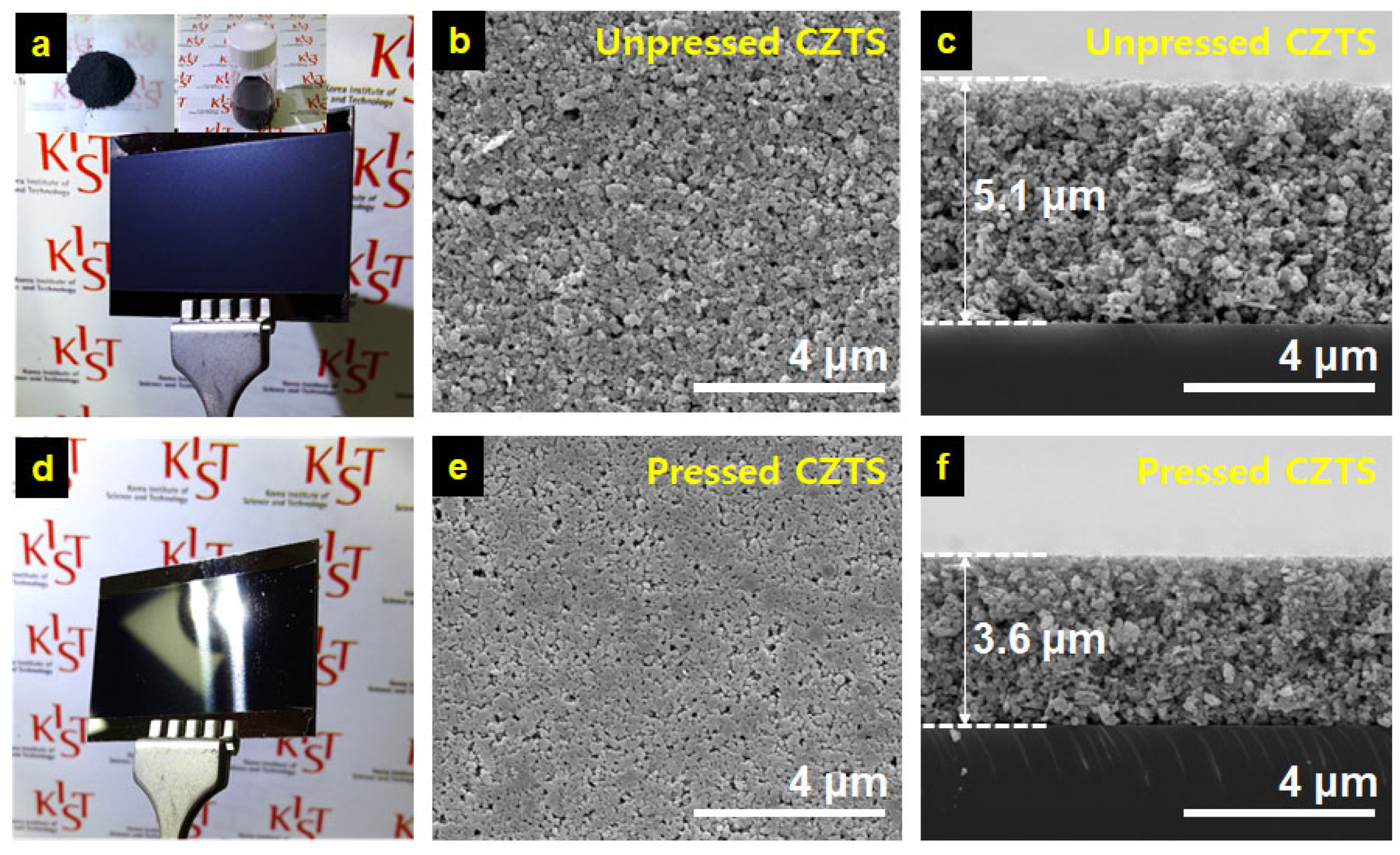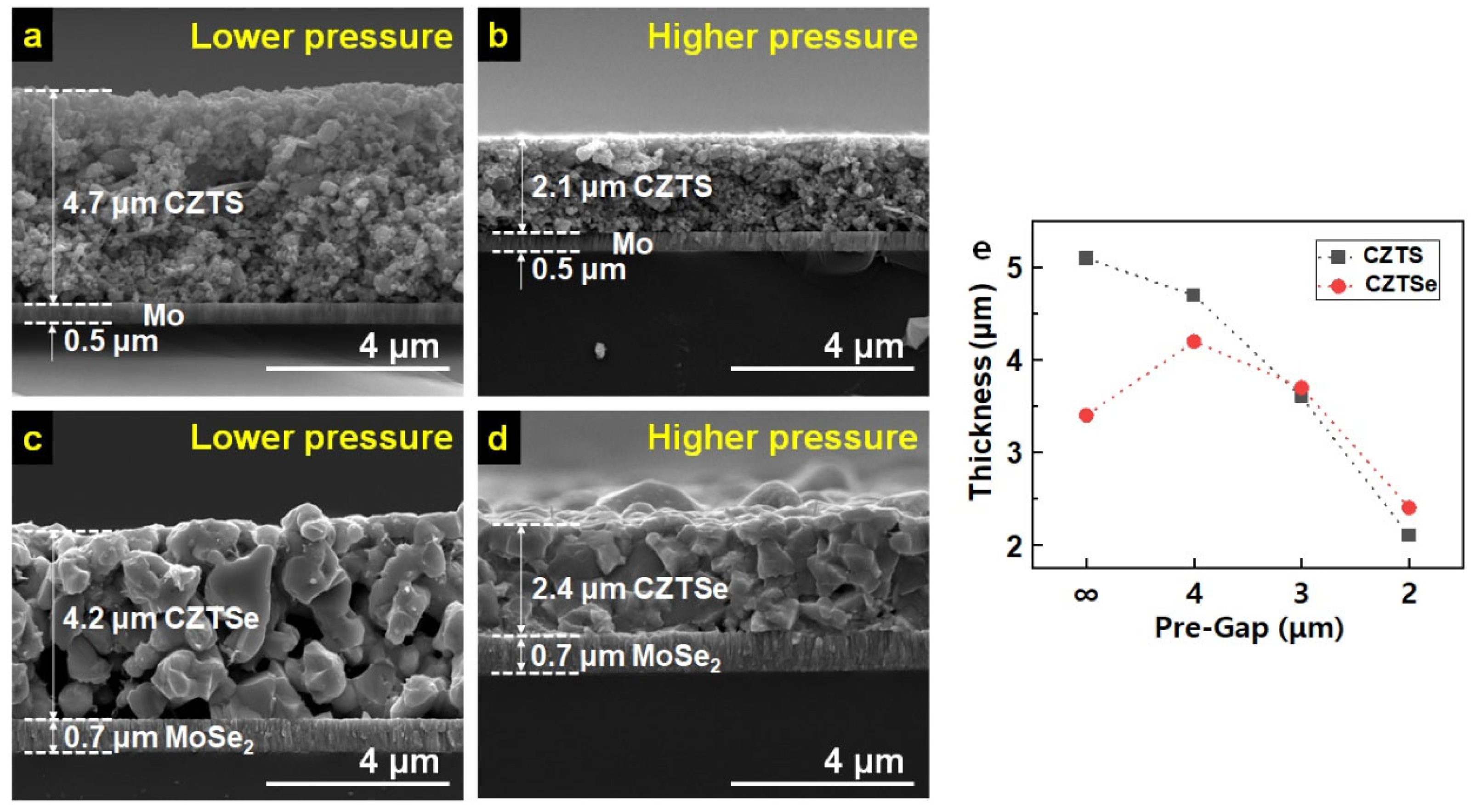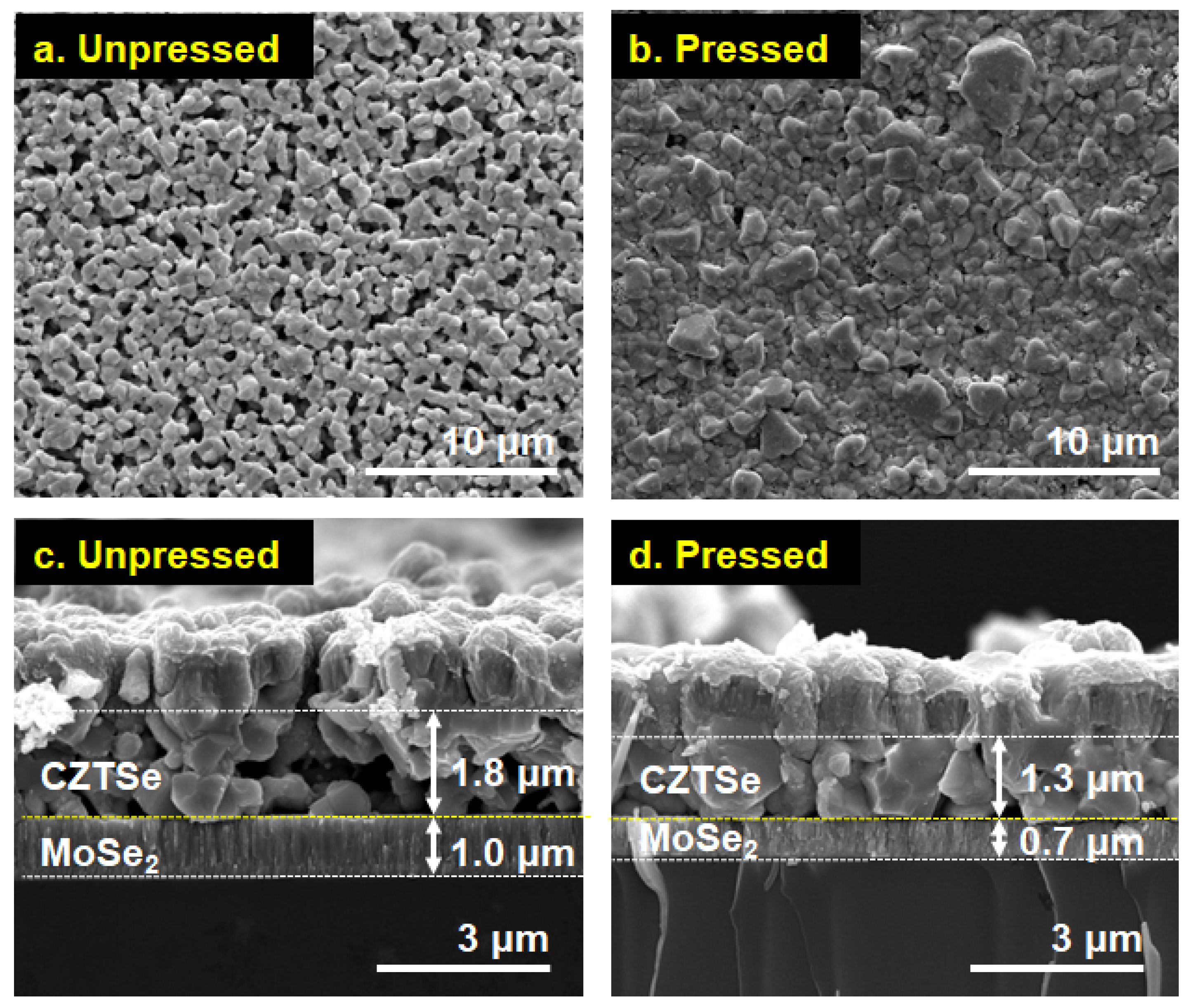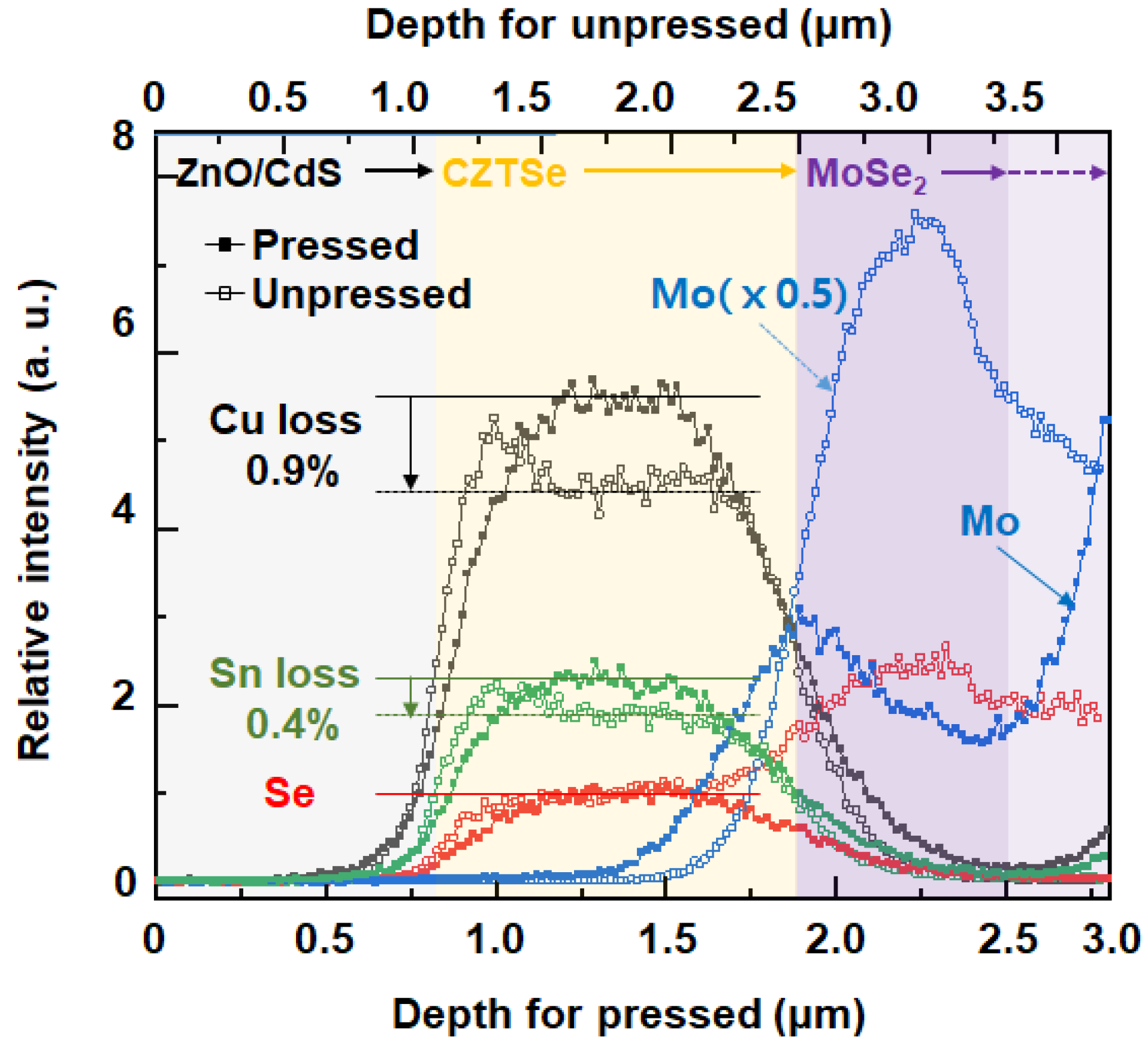Performance Enhancement in Powder-Fabricated Cu2(ZnSn)Se4 Solar Cell by Roll Compression
Abstract
1. Introduction
2. Materials and Methods
3. Results and Discussion
4. Discussion and Conclusions
Supplementary Materials
Author Contributions
Funding
Institutional Review Board Statement
Informed Consent Statement
Data Availability Statement
Conflicts of Interest
References
- Nugroho, H.S.; Refantero, G.; Septiani, N.L.W.; Iqbal, M.; Marno, S.; Abdullah, H.; Prima, E.C.; Nugraha; Yuliarto, B. A Progress Review on the Modification of CZTS(e)-based thin-film solar cells. J. Ind. Eng. Chem. 2022, 105, 83–110. [Google Scholar] [CrossRef]
- Tang, A.Y.; Li, Z.L.; Wang, F.; Dou, M.L.; Pan, Y.Y.; Guan, J.Y. One Step Electrodeposition of Cu2ZnSnS4 Thin Films in a Novel Bath with Sulfurization Free Annealing. Appl. Surf. Sci. 2017, 402, 70–77. [Google Scholar] [CrossRef]
- Zhou, H.P.; Hsu, W.C.; Duan, H.S.; Bob, B.; Yang, W.B.; Song, T.B.; Hsu, C.J.; Yang, Y. CZTS Nanocrystals: A Promising Approach for Next Generation Thin Film Photovoltaics. Energy Environ. Sci. 2013, 6, 2822–2838. [Google Scholar] [CrossRef]
- Lai, F.I.; Yang, J.F.; Hsu, Y.C.; Kuo, S.Y. Location-Optoelectronic Property Correlation in ZnO:Al Thin Film by RF Magnetron Sputtering and Its Photovoltaic Application. Materials 2021, 14, 6313. [Google Scholar] [CrossRef]
- Oliveri, R.L.; Patella, B.; Pisa, F.D.; Mangione, A.; Aiello, G.; Inguanta, R. Fabrication of CZTSe/CIGS Nanowire Arrays by One-Step Electrodeposition for Solar-Cell Application. Materials 2021, 14, 2778. [Google Scholar] [CrossRef]
- Yang, Y.; Wang, G.; Zhao, W.; Tian, Q.; Huang, L.; Pan, D. Solution-Processed Highly Efficient Cu2ZnSnSe4 Thin Film Solar Cells by Dissolution of Elemental Cu, Zn, Sn, and Se Powders. ACS App. Mater. Interfaces 2015, 7, 460–464. [Google Scholar] [CrossRef]
- Balaz, P.; Balaz, M.; Achimovicova, Z.; Bujinakova, Z.; Dutkova, E. Chalcogenide Mechanochemistry in Materials Science: Insight into Synthesis and Applications (a Review). J. Mater. Sci. 2017, 52, 11851–11890. [Google Scholar] [CrossRef]
- Chen, S.Y.; Yang, J.H.; Gong, X.G.; Walsh, A.; Wei, S.H. Intrinsic Point Defects and Complexes in the Quaternary Kesterite Semiconductor Cu2ZnSnS4. Appl. Surf. Sci. 2017, 402, 70–77. [Google Scholar]
- Song, B.-G.; Ahn, H.-Y.; Park, B.-I.; Park, H.-H.; Ju, B.-K.; Lee, S.Y.; Park, J.K.; Cho, S.-H. Effects of compression and controlled selenization on powder-fabricated Cu(In,Ga)Se2 thin films. Appl. Surf. Sci. 2019, 475, 158–161. [Google Scholar] [CrossRef]
- Bag, S.; Gunawan, O.; Gokmen, T.; Zhu, Y.; Todorov, T.K.; Mitzi, D.B. Low Band Gap Liquid-Processed CZTSe solar cell with 10.1% efficiency. Energy Environ. Sci. 2012, 5, 7060. [Google Scholar] [CrossRef]
- Todorov, T.K.; Reuter, K.B.; Mitzi, D.B. High-Efficiency Solar Cell with Earth-Abundant Liquid-Processed Absorber. Adv. Mater. 2010, 22, E156. [Google Scholar] [CrossRef]
- Wang, W.; Winkler, M.T.; Gunawan, O.; Gokmen, T.; Todorov, T.K.; Zhu, Y.; Mitzi, D.B. Device Characteristics of CZTSSe Thin-Film Solar Cells with 12.6% Efficiency. Adv. Energy Mater. 2014, 4, 1301465. [Google Scholar] [CrossRef]
- Sravani, L.; Routray, S.; Courel, M.; Pradhan, K.P. Loss Mechanisms in CZTS and CZTSe Kesterite Thin-Film Solar Cells: Understanding the Complexity of Defect Density. Sol. Energy 2021, 227, 56. [Google Scholar] [CrossRef]
- Li, J.; Huang, J.; Ma, F.; Sun, H.; Cong, J.; Privat, K.; Webster, R.F.; Cheng, S.; Yao, Y.; Chin, R.L.; et al. Unveiling Microscopic Carrier Loss Mechanisms in 12% Efficient Cu2ZnSnSe4 Solar Cells. Nat. Energy 2022, 7, 754. [Google Scholar] [CrossRef]
- Kurley, J.M.; Pan, J.; Wang, Y.; Zhang, Y.W.; Russell, J.C.; Pach, G.F.; To, B.; Luther, J.M.; Talapin, D.V. Roll-To-Roll Friendly Solution-Processing of Ultrathin, Sintered CdTe Nanocrystal Photovoltaics. ACS App. Mater. Interfaces 2021, 13, 44165. [Google Scholar] [CrossRef]
- Todorov, T.; Hillhouse, H.W.; Azazou, S.; Sekkat, Z.; Vigil-Galán, O.; Deshmukh, S.D.; Agrawal, R.; Bourdais, S.; Valdés, M.; Arnou, P.; et al. Solution-Based Synthesis of kesterite thin film semiconductors. J. Phys. Energy 2020, 2, 012003. [Google Scholar] [CrossRef]
- López-Marino, S.; Sánchez, Y.; Espíndola-Rodríguez, M.; Alcobé, X.; Xie, H.; Neuschitzer, M.; Becerril, I.; Giraldo, S.; Dimitrievska, M.; Placidi, M.; et al. Alkali Doping Strategies for Flexible and Light-Weight Cu2ZnSnSe4 Solar Cells. J. Mater. Chem. A 2016, 4, 1895. [Google Scholar] [CrossRef]
- Chen, G.; Liu, W.; Jiang, G.; Pan, B.; Zhu, C. Effect of Compact Structure on the Phase Transition in the Oxides Derived Cu2ZnSnSe4 Thin Films. Sol. Energy 2013, 92, 172. [Google Scholar] [CrossRef]
- Chen, G.; Pan, B.; Jin, L.; Jiang, G.; Liu, W.; Zhu, C. Compression for Smoothing and Densifying CuInSe2 and Cu2ZnSnSe4 Thin Films Coating from Oxides Nanoparticles Precursor. J. Alloys Comp. 2014, 610, 20. [Google Scholar] [CrossRef]
- Gershon, T.; Shin, B.; Bojarczuk, N.; Hopstaken, M.; Mitzi, D.B.; Guha., S. The Role of Sodium as a Surfactant and Suppressor of Non-Radiative Recombination at Internal Surfaces in Cu2ZnSn. Adv. Energy Mater. 2015, 5, 1400849. [Google Scholar] [CrossRef]
- Shannon, R.D. Revised Effective Ionic-Radii and Systematic Studies of Interatomic Distances in Halides and Chalcogenides. Acta. Crystallogr. A 1976, 32, 751–767. [Google Scholar] [CrossRef]
- He, J.; Sun, L.; Chen, S.Y.; Chen, Y.; Yang, P.X.; Chu, J.H. Composition Dependence of Structure and Optical Properties of Cu2ZnSn(S,Se)(4) Solid Solutions: An Experimental Study. J. Alloy. Compd. 2012, 511, 129–132. [Google Scholar] [CrossRef]
- Tasksen, T.; Neerken, J.; Schoneberg, J.; Pareek, D.; Seininger, V.; Parisi, J.; Gütay, L. Device Characteristics of an 11.4% CZTSe Solar Cell Fabricated from Sputtered Precursors. Adv. Energy Mater. 2018, 8, 1703295. [Google Scholar] [CrossRef]
- Suryawanshi, M.P.; Agawane, G.L.; Bhosale, S.M.; Shin, S.W.; Patil, P.S.; Kim, J.H.; Moholkar, A.V. CZTS Based Thin Film Solar Cells: A Status Review. Mater. Technol. 2013, 28, 98–109. [Google Scholar] [CrossRef]
- Qu, Y.; Zoppi, G.; Beattie, N.S. Selenization Kinetics in Cu2ZnSn(S,Se)4 solar cells prepared from nanoparticle inks. Sol. Energy Mater. Sol. Cells. 2016, 158, 130–137. [Google Scholar] [CrossRef]
- Cheng, K.; Kuang, Z.; Liu, J.; Liu, X.; Jin, R.; Lu, Z.; Liu, Y.; Guo, L.; Du, Z. Fabrication of CZTSSe Absorbers by Optimized Selenization of One-Step Co-electrodeposited CZTS precursors. J. Mater. Sci. 2017, 52, 11014–11024. [Google Scholar] [CrossRef]
- Wunderlich, B.; Shu, H.-C. The Crystallization and Melting of Selenium. J. Cryst. 1980, 48, 227–239. [Google Scholar] [CrossRef]
- Ning, Z.; Da-Ming, Z.; Gong, Z. An investigation on preparation of CIGS targets by sintering process. Mater. Sci. Eng. B 2010, 166, 34–40. [Google Scholar] [CrossRef]
- Martinez-Ayala, A.; Pal, M.; Mathews, N.R.; Mathew, X. Thermal treatments and characterization of CZTS thin films deposited using nanoparticle ink. Can. J. Phys. 2014, 92, 875–878. [Google Scholar] [CrossRef]
- Hwang, Y.; Ahn, B.-I.; Lee, B.-S.; Kim, J.Y.; Jeong, J.-H.; Kim, H.; Ko, M.J.; Kim, B.; Son, H.J.; Lee, S.Y.; et al. Influences of extended selenization on Cu2ZnSnSe4 solar cells prepared from quaternary nanocrystal ink. J. Phys. Chem. C 2014, 118, 27657–27663. [Google Scholar] [CrossRef]
- Hsiao, K.J.; Liu, J.D.; Hsieh, H.H.; Jiang, T.S. Electrical Impact of MoSe2 on CIGS Thin-Film Solar Cells. Phys. Chem. Chem. Phys. 2013, 15, 18174–18178. [Google Scholar] [CrossRef]
- Moustafa, M.; Al Zoubi, T.; Yasin, S. Numerical Analysis of the Role of p-MoSe2 Interfacial Layer in CZTSe Thin-film Solar Cells using SCAPS Simulation. Optik 2021, 247, 167885. [Google Scholar] [CrossRef]
- Yao, L.; Ao, J.; Jeng, M.J.; Bi, J.; Gao, S.; Sun, G.; He, Q.; Zhou, Z.; Sun, Y.; Chang, L.B. Effect of Sn Content in a CuSnZn Metal Precursor on Formation of MoSe2 Film during Selenization in Se+SnSe Vapor. Materials 2021, 14, 6313. [Google Scholar]
- Azzouzi, M.; Cabas-Vidani, A.; Haass, S.G.; Röhr, J.A.; Rpamyuk, Y.E.; Tiwari, A.N.; Nelson, J. Analysis of the Voltage Losses in CZTSSe Solar Cells of Varying Sn Content. J. Phys. Chem. Lett. 2019, 10, 2829–2835. [Google Scholar] [CrossRef]
- Ray, G.; Redinger, A.; Sendler, J.; Weiss, T.P.; Thevenin, M.; Guennou, M.; El Adib, B.; Siebentritt, S. The Band Gap of Cu2ZnSnSe4: Effect of Order-Disorder. Appl. Phys. Lett. 2014, 105, 112106. [Google Scholar] [CrossRef]







Disclaimer/Publisher’s Note: The statements, opinions and data contained in all publications are solely those of the individual author(s) and contributor(s) and not of MDPI and/or the editor(s). MDPI and/or the editor(s) disclaim responsibility for any injury to people or property resulting from any ideas, methods, instructions or products referred to in the content. |
© 2023 by the authors. Licensee MDPI, Basel, Switzerland. This article is an open access article distributed under the terms and conditions of the Creative Commons Attribution (CC BY) license (https://creativecommons.org/licenses/by/4.0/).
Share and Cite
Park, J.; Nam, H.; Song, B.-G.; Burak, D.; Jang, H.S.; Lee, S.Y.; Cho, S.-H.; Park, J.-K. Performance Enhancement in Powder-Fabricated Cu2(ZnSn)Se4 Solar Cell by Roll Compression. Materials 2023, 16, 1076. https://doi.org/10.3390/ma16031076
Park J, Nam H, Song B-G, Burak D, Jang HS, Lee SY, Cho S-H, Park J-K. Performance Enhancement in Powder-Fabricated Cu2(ZnSn)Se4 Solar Cell by Roll Compression. Materials. 2023; 16(3):1076. https://doi.org/10.3390/ma16031076
Chicago/Turabian StylePark, Jaehyun, Hyobin Nam, Bong-Geun Song, Darya Burak, Ho Seong Jang, Seung Yong Lee, So-Hye Cho, and Jong-Ku Park. 2023. "Performance Enhancement in Powder-Fabricated Cu2(ZnSn)Se4 Solar Cell by Roll Compression" Materials 16, no. 3: 1076. https://doi.org/10.3390/ma16031076
APA StylePark, J., Nam, H., Song, B.-G., Burak, D., Jang, H. S., Lee, S. Y., Cho, S.-H., & Park, J.-K. (2023). Performance Enhancement in Powder-Fabricated Cu2(ZnSn)Se4 Solar Cell by Roll Compression. Materials, 16(3), 1076. https://doi.org/10.3390/ma16031076





